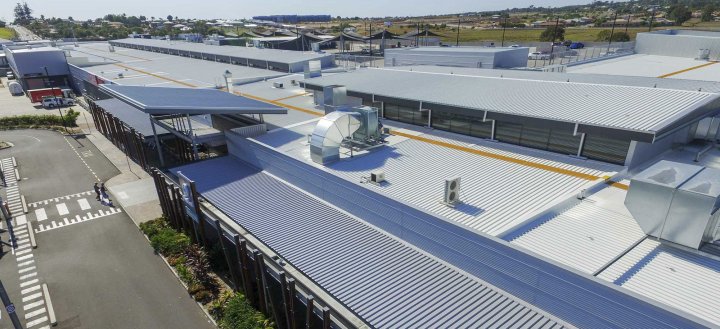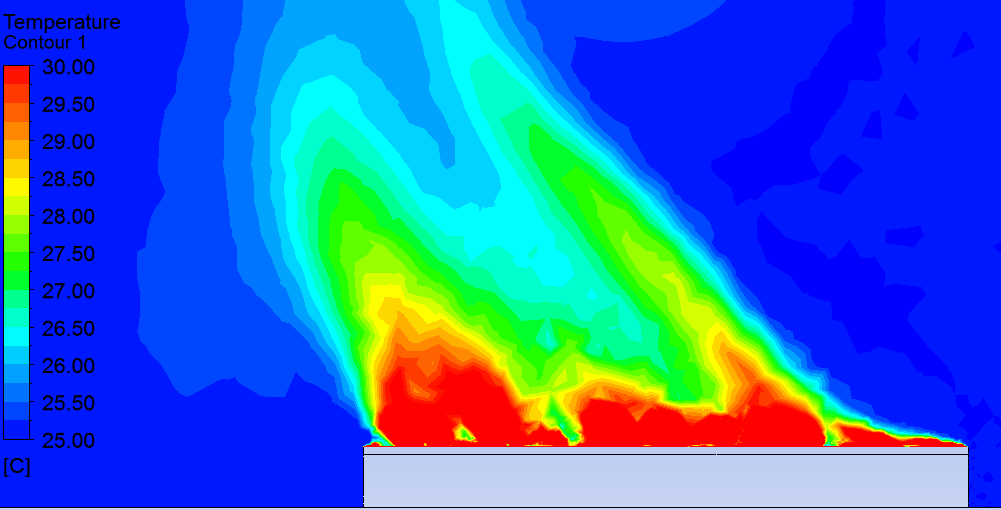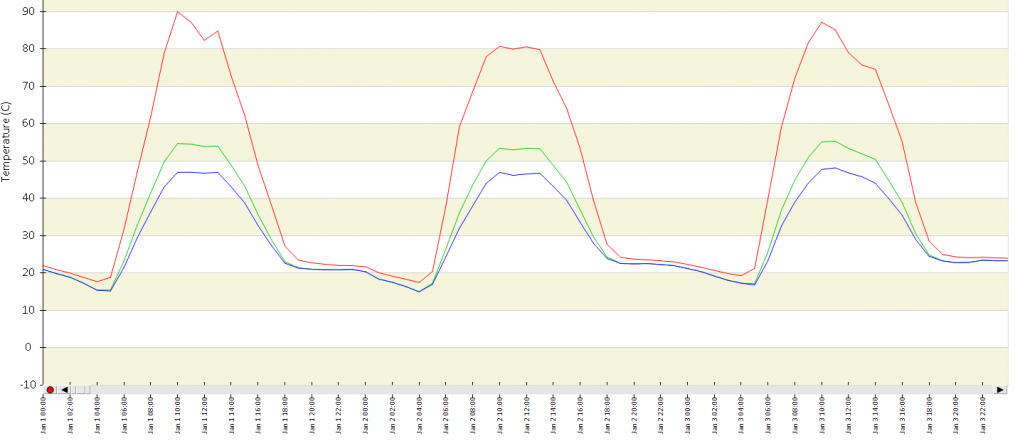
Cool roofs, such as COLORBOND® Coolmax® steel have been designed to have a high solar reflectance and high thermal emittance. A surface with high solar reflectance will reflect most of the direct solar radiation back to the sky, reducing the amount of heat to the building. A high thermal emittance surface allows roof heat to be emitted back to the sky as long-wave radiation, which ensures that less heat enters the building, reducing the amount of cooling required.

Measured results from real buildings indicate that the cooling performance improvement provided by cool roofs is significantly higher than what is predicted from thermal modelling in building simulation software. A number of studies indicate that the roof microclimate, particularly on large roofs, plays an important part that is not considered by building simulation tools at present. In particular, building simulation tools of necessity use simplified functions for convection, and these are usually the same for any type of roof, regardless of size or height. In many cases this is not a concern, but for large roofs the impacts are substantial. Convection of heat away from the roof interacts with roof surface temperature and emitted radiation, which will affect the amount of heat absorbed into the space.
Detailed analysis has been conducted by Arup using Computational Fluid Dynamics and dynamic thermal simulation. The study compared COLORBOND® Coolmax® steel and COLORBOND® steel in the colour of Surfmist® to a standard ZINCALUME® steel for a 5,000 m2 shopping centre roof. This has provided more detailed understanding of the thermal interactions in large-scale roofs. This includes the effects of wind speed, wind direction and absorbed solar radiation. It also included the effects of elevated local air temperature on rooftop mechanical plant. The effects were analysed for climates in Hervey Bay, Ipswich, Western Sydney and Northern Melbourne.
The study demonstrated that standard building energy simulations for large surfaced rooftops underrepresent localised heat island effects by using coefficients of convective heat transfer that are too high. Using the correct coefficients leads to higher roof surface temperatures and therefore higher heat loads. The high solar reflectance and high thermal emittance values of the COLORBOND® Coolmax® steel and COLORBOND® steel in Surfmist® steel roofs mitigate against this by reducing the total absorbed radiation, as well as emitting away more heat as long wave radiation. Consequently, the COLORBOND® Coolmax® steel and Surfmist® steel roofs had a much lower surface temperature than ZINCALUME® steel roofs.
Once the convective behaviour is more accurately accounted for, the annual cooling energy, roof temperature and peak demand are higher, and much more so for standard roofs such as ZINCALUME® steel than for COLORBOND® Coolmax® steel or COLORBOND® steel in Surfmist®. The predicted operational savings for COLORBOND® steel in Surfmist® and COLORBOND® Coolmax® steel were 2.3-2.4 times the savings predicted under standard modelling techniques, all other things being equal.
For the climates and conditions modelled, the roof made from COLORBOND® Coolmax® steel was shown to provide the greatest benefit for reducing energy use and peak demand1. COLORBOND® Coolmax® steel reduced cooling energy consumption by 6.4% to 14.4% (depending on climate) compared to ZINCALUME® steel, with a peak demand reduction of 4.4% to 9.7%. In general, this effect was greater for areas with higher peak and average temperatures, although this can also be influenced by other factors such as low wind speed.

Total HVAC annual energy savings were higher for buildings in more northern latitudes, in part due to the interaction of cooling and heating. In all cases analysed, there was an operational cost saving and greenhouse gas saving when using the COLORBOND® Coolmax® steel or COLORBOND® steel in Surfmist® steel roof. Operational cost savings ranged from $2,067 to $6,6452 and greenhouse gas emission savings ranged from 18,466 kgCO2 to 29,936 kgCO24 for COLORBOND® Coolmax® steel over ZINCALUME® steel.
In most cooling-dominated climates and/or buildings5, a COLORBOND® Coolmax® steel roof can provide an annual energy saving equivalent to large amounts of insulation. The study showed that for Ipswich6, a building with a ZINCALUME® steel roof with R3.45 insulation to meet Section J requirements used the same amount of energy as a building with a COLORBOND® Coolmax® steel roof with R0.30 insulation. This effect varies with the exact climate.
| COLORBOND® Coolmax® steel results compared to standard ZINCALUME® steel roof | Hervey Bay QLD | Ipswich QLD | Western Sydney NSW | Northern Melbourne VIC |
|---|---|---|---|---|
| Cooling energy savings (%) | 6.4% | 10.5% | 13.7% | 14.4% |
| Annual operational savings2 | $6,558 | $6,124 | $6,645 | $2,067 |
| Capital cost savings3 | $69,200 | $89,100 | $126,500 | $42,400 |
| GHG Savings (kg CO2)4 | 24,397 | 22,781 | 29,936 | 18,466 |
Key factors that will strongly influence any energy and peak demand savings provided by a cool roof include the proportion of cooling compared to heating, and the proportion of cooling at peak demand. Energy benefits are provided for cooling-dominated buildings. Peak demand benefits are seen when cooling energy is a significant proportion of the variable load. Other factors that will affect the impact of a cool roof on energy use and peak demand include plant efficiency, roof size, and building layout.
Note that the cost savings are a high level estimate based on a median annual electricity fee of $0.25 per kWh, and gas costs of $0.04 per kWh. Savings may also vary depending on factors such as current and future utility tariffs, building operation, building form, roof size and climatic conditions.
Capital cost savings based on $929/kWr, assuming plant can be installed with lower capacity alternatives, as well as reductions in pipe and duct size.
Greenhouse gas emissions are calculated based on Scope 3 emissions as follows: Electricity 0.93 kgCO2/kWh in QLD, 0.99 kgCO2/kWh in NSW, and 1.34 kgCO2/kWh in VIC. Gas 0.064 kgCO2/kWh in NSW, and 0.055 kgCO2/kWh in VIC.
Typically, greater benefits will be seen in areas and buildings with less heating requirements, and climates with lower wind speeds.
This saving was based on a simulation of one year of operation using a Typical Meteorological Year (TMY) weather file.
For more information download reports:


